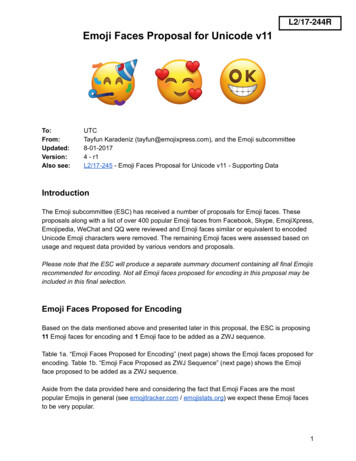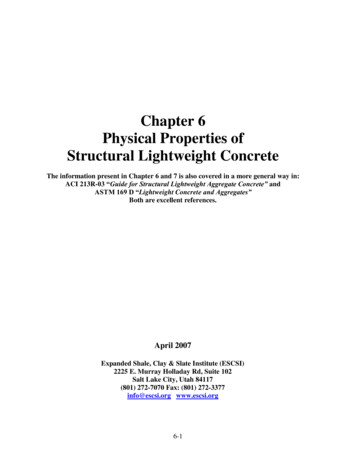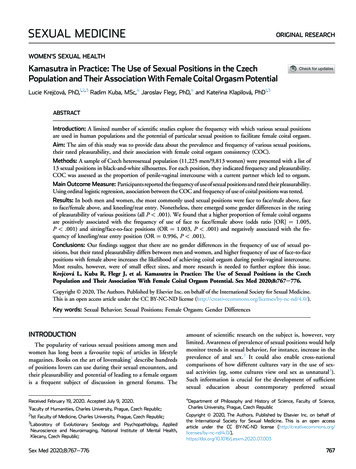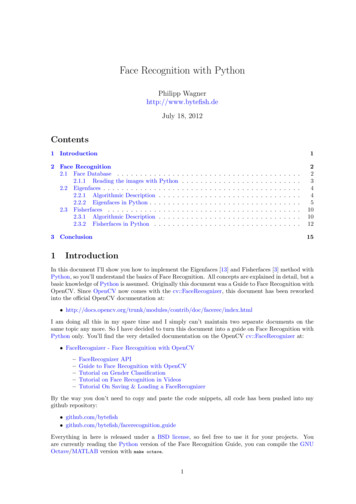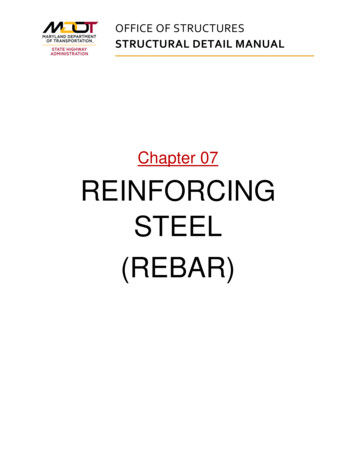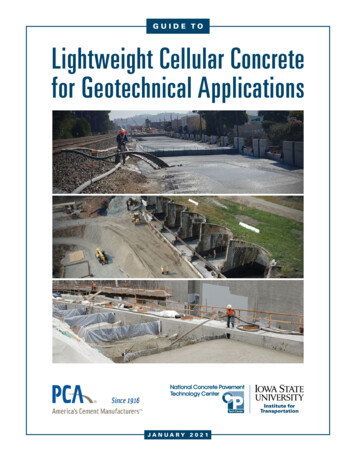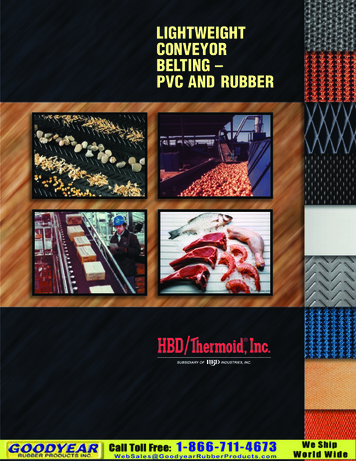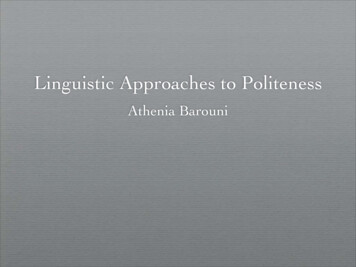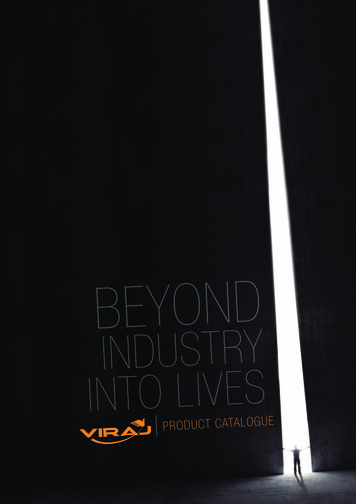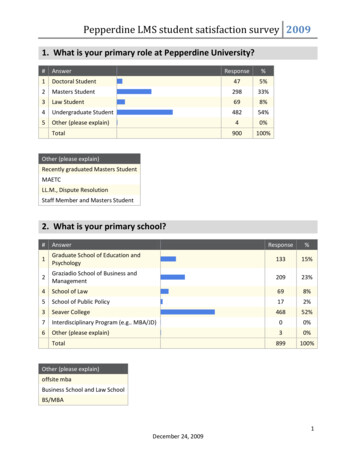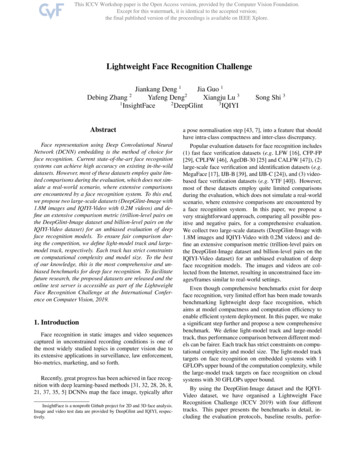
Transcription
Lightweight Face Recognition ChallengeJiankang Deng 1Jia Guo 12Debing ZhangYafeng DengXiangju Lu 3123InsightFaceDeepGlintIQIYI2Song Shi 3Abstracta pose normalisation step [43, 7], into a feature that shouldhave intra-class compactness and inter-class discrepancy.Face representation using Deep Convolutional NeuralNetwork (DCNN) embedding is the method of choice forface recognition. Current state-of-the-art face recognitionsystems can achieve high accuracy on existing in-the-wilddatasets. However, most of these datasets employ quite limited comparisons during the evaluation, which does not simulate a real-world scenario, where extensive comparisonsare encountered by a face recognition system. To this end,we propose two large-scale datasets (DeepGlint-Image with1.8M images and IQIYI-Video with 0.2M videos) and define an extensive comparison metric (trillion-level pairs onthe DeepGlint-Image dataset and billion-level pairs on theIQIYI-Video dataset) for an unbiased evaluation of deepface recognition models. To ensure fair comparison during the competition, we define light-model track and largemodel track, respectively. Each track has strict constraintson computational complexity and model size. To the bestof our knowledge, this is the most comprehensive and unbiased benchmarks for deep face recognition. To facilitatefuture research, the proposed datasets are released and theonline test server is accessible as part of the LightweightFace Recognition Challenge at the International Conference on Computer Vision, 2019.Popular evaluation datasets for face recognition includes(1) fast face verification datasets (e.g. LFW [16], CFP-FP[29], CPLFW [46], AgeDB-30 [25] and CALFW [47]), (2)large-scale face verification and identification datasets (e.g.MegaFace [17], IJB-B [39], and IJB-C [24]), and (3) videobased face verification datasets (e.g. YTF [40]). However,most of these datasets employ quite limited comparisonsduring the evaluation, which does not simulate a real-worldscenario, where extensive comparisons are encountered bya face recognition system. In this paper, we propose avery straightforward approach, comparing all possible positive and negative pairs, for a comprehensive evaluation.We collect two large-scale datasets (DeepGlint-Image with1.8M images and IQIYI-Video with 0.2M videos) and define an extensive comparison metric (trillion-level pairs onthe DeepGlint-Image dataset and billion-level pairs on theIQIYI-Video dataset) for an unbiased evaluation of deepface recognition models. The images and videos are collected from the Internet, resulting in unconstrained face images/frames similar to real-world settings.1. IntroductionFace recognition in static images and video sequencescaptured in unconstrained recording conditions is one ofthe most widely studied topics in computer vision due toits extensive applications in surveillance, law enforcement,bio-metrics, marketing, and so forth.Recently, great progress has been achieved in face recognition with deep learning-based methods [31, 32, 28, 26, 8,21, 37, 35, 5] DCNNs map the face image, typically afterInsightFace is a nonprofit Github project for 2D and 3D face analysis.Image and video test data are provided by DeepGlint and IQIYI, respectively.Even though comprehensive benchmarks exist for deepface recognition, very limited effort has been made towardsbenchmarking lightweight deep face recognition, whichaims at model compactness and computation efficiency toenable efficient system deployment. In this paper, we makea significant step further and propose a new comprehensivebenchmark. We define light-model track and large-modeltrack, thus performance comparison between different models can be fairer. Each track has strict constraints on computational complexity and model size. The light-model tracktargets on face recognition on embedded systems with 1GFLOPs upper bound of the computation complexity, whilethe large-model track targets on face recognition on cloudsystems with 30 GFLOPs upper bound.By using the DeepGlint-Image dataset and the IQIYIVideo dataset, we have organised a Lightweight FaceRecognition Challenge (ICCV 2019) with four differenttracks. This paper presents the benchmarks in detail, including the evaluation protocols, baseline results, perfor-
mance analysis of the top-ranked submissions received aspart of the competition, challenge cases analysis within thelarge-scale image and video face recognition, and effectivestrategies for deep face recognition.2. DatasetsThe following subsections present the dataset statisticsof the lightweight face recognition challenge. The preprocessed training and testing datasets are publicly available for research purposes and can be downloaded from ourwebsite.2.1. Training DatasetOur training dataset is cleaned from the MS1M [9]dataset. All face images are pre-processed to the sizeof 112 112 by the five facial landmarks predicted byRetinaFace [6]. Then, we conduct a semi-automatic refinement by employing the pre-trained ArcFace [5] modeland ethnicity-specific annotators. Finally, we get a refinedMS1M dataset named MS1M-RetinaFace, which contains5.1M images of 93K identities. The training data is fixedto facilitate future comparison and reproduction. Detailedrequirements: All participants must use this dataset for training without any modification (e.g. re-alignment or changingimage size are both prohibited). Any external dataset is not allowed.2.2. Large-scale Image Test SetWe take the DeepGlint-Image dataset as our large-scaleimage test set. The DeepGlint-Image dataset consists of thefollowing two parts: ELFW: Face images of celebrities in the LFW [16]name list. There are 274K images from 5.7K identities. DELFW: Distractors for ELFW. There are 1.58M faceimages from Flickr.All test images are pre-processed to the size of 112 112(same as the training data). Modification (e.g. re-alignmentor resize) on test images is not allowed. Horizontal flippingis allowed for test augmentation while all other test argumentation methods are prohibited. The multi-model ensemble strategy is also not allowed.2.3. Large-scale Video Test SetWe take the IQIYI-Video dataset as our large-scale videotest set. The IQIYI-Video dataset is collected from IQIYIvariety shows, films and television dramas. The length ofeach video ranges from 1 to 30 seconds. The IQIYI-Videodataset includes 200K videos of 10K IYI-Video# ID93K5.7K10K# Image/frame5.1M274K 1.58M(Distractors)6.3M(from 200K videos)Table 1. Statistics of the training and testing sets of the lightweightface recognition challenge.Face frames are extracted from each video at 8FPS andpre-processed to the size of 112 112 (same as the training data). We provide 6.3M pre-processed face crops instead of original videos to simplify the competition. Themapping between videos and frames are also provided andparticipants can investigate how to aggregate frame featuresto video feature. Modification (e.g. re-alignment or resize)on test images is not allowed. Horizontal flipping is allowed for test augmentation while all other test argumentation methods are prohibited. The multi-model ensemblestrategy is also not allowed.2.4. Dataset StatisticsDataset statistics of the lightweight face recognitionchallenge are presented in Table 1. MS1M-RetinaFace isused as the training dataset, while DeepGlint-Image andIQIYI-Video are employed as the large-scale image andvideo test datasets, respectively.3. Evaluation ProtocolsThe lightweight face recognition challenge has four protocols for evaluation. All four protocols correspond to 1:1verification protocols, where a face recognition model is expected to classify a pair of images/videos as positive or negative pair. More specifically, we choose TPR@FPR as ourevaluation metric. A detailed description of each protocolwith different constraints on the computational complexityis given below: Protocol-1 (DeepGlint-Light) evaluates a lightweightface recognition model for its ability to distinguish image pairs with high precision (FPR@1e-8). Protocol-2 (DeepGlint-Large) evaluates a large facerecognition model for its ability to distinguish imagepairs with high precision (FPR@1e-8). Protocol-3 (IQIYI-Light) evaluates a lightweight facerecognition model for its ability to distinguish videopairs with high precision (FPR@1e-4). Protocol-4 (IQIYI-Large) evaluates a large face recognition model for its ability to distinguish video pairswith high precision (FPR@1e-4).3.1. Light Model ConstraintsIn the light model track, we refer the application scenarioof unlocking mobile telephone with smooth user experience( 50ms on ARM). Detailed requirements:
DatasetDeepGlint-ImageIQIYI-Video# Positive11,039,5331,550,033# Negative330,145,575,21714,561,114,695Table 2. Positive and negative pair numbers within the image andvideo testing sets of the lightweight face recognition challenge. The upper bound of computational complexity is 1GFLOPs. The upper bound of model size is 20MB. We target on float32 solutions. Float16, int8 or anyother quantization methods are not allowed. The upper bound of the feature dimension is 512.3.2. Large Model ConstraintsIn the large model track, we refer to the submissionrequirement of the face recognition vendor test ( 1s onCPU). Detailed requirements: The upper bound of computational complexity is 30GFLOPs. We target on float32 solutions. Float16, int8 or anyother quantization methods are not allowed. The upper bound of the feature dimension is 512.3.3. Pair StatisticsTo correctly follow the above-mentioned protocol andreport the corresponding accuracy, we use a mask matrixto extract relevant positive and negative pairs. In Table 2,we give the positive and negative pair numbers within theimage and video testing sets. We believe extensive paircomparison (e.g. trillion-level for images and billion-levelfor videos) can provide an unbiased evaluation for the facerecognition models.Input1122 3562 32282 64282 64142 12872 12872 12842 512OperatorConv3 3Depthwise Conv3 3Depthwise ConvDepthwise ConvDepthwise ConvDepthwise ConvConv3 3FC4. Baseline SolutionsBaseline models are released before the challenge to facilitate participation. We customise the MobileNet [13] forthe light baseline model and the ResNet [10] for the largebaseline model. We employ ArcFace [5] as our loss function, which is one of the top-performing methods for deepface recognition.Light Baseline Model. The detailed network configurationof our light baseline model is summarised in Table 3. Thec326464128128128512256n131017511-s2212212-Table 3. The network configuration of our light baseline model.Each line represents a sequence of identical layers, repeating ntimes. All layers in the same sequence have the same number c ofoutput channels. The first layer of each sequence has a stride s.The expansion factor t is always applied to the input size.computational complexity is 1.0G FLOPS and the modelsize is 19.80MB.Large Baseline Model. As shown in Table 4, we useResNet124 [10, 5] as our large baseline model. Comparedto ResNet100, the block setting is changed to (3, 13, 40,5), making model deeper. The computational complexity is29.70G FLOPS and the model size is 297MB.layer name124-layeroutput sizeInput Image CropConv2 x3 3, 64, stride 1 3 3, 64 33 3, 64112 112 3112 112 6456 56 64Conv3 x 3 3, 1283 3, 128 1328 28 128Conv4 x 3 3, 2563 3, 256 4014 14 256Conv5 x 3 3, 5123 3, 512 3.4. Submission FormatWe have released an online test server for efficient evaluations. For the DeepGlint-Image test set, the participantsneed to submit a binary feature matrix (ImageNum FeatureDim in float32) to the test server. For the IQIYI-Videotest set, the participants also need to submit a binary feature matrix (VideoNum FeatureDim in float32) to the testserver.t12242-FC 57 7 5121 1 512Table 4. The network configuration of our large baseline model.Convolutional building blocks are shown in brackets with the numbers of blocks stacked. Down-sampling is performed by the second conv in conv2 1, conv3 1, conv4 1, and conv5 1 with a strideof 2.4.1. Implementation DetailsDuring training, we follow [5] to set the feature scale to64 and choose the angular margin of ArcFace at 0.5. The
baseline models are implemented by MXNet [3] with parallel acceleration on both features and centres1 . We setthe batch size to 512 and train models on four NVIDIATesla P40 (24GB) GPUs. We divide the learning rate at100K,160K,220K iterations and finish at 240K iterations.We set the momentum to 0.9 and weight decay to 5e 4.During testing, we only keep the feature embedding network without the fully connected layer and extract the 512D features for each normalised face crop. To get the embedding features for videos, we simply calculate the featurecentre of all frames from the video. Flip testing is usedin our baseline models by addition and then normalisation.The extracted features are compared using Cosine distance,followed by a threshold to distinguish positive or negativepairs.5. Top-ranked Competition SolutionsThe lightweight face recognition competition is conducted as part of the Lightweight Face Recognition Challenge & Workshop2 , at the International Conference onComputer Vision 2019 (ICCV 2019). All participatingteams are provided with the training and the testing datasets.Participants are required to develop a face feature embedding algorithm, which is automatically evaluated on our testserver based on the above-mentioned four protocols.The competition has been opened worldwide, to bothindustry and academic institutions. The competition hasreceived 292 registrations from across the world. Morespecifically, the competition has received 112 submissionsfor the DeepGlint-Light track, 91 submissions for theDeepGlint-Large track, 53 submissions for the IQIYI-Lighttrack, and 45 submissions for the IQIYI-Large track. Here,multi-submissions for one protocol from the same participant is only counted for once. After the competition, weclose the test server and select the valid top-3 solutions foreach protocol. We collect the training code from these topranked participants and re-train the models to confirm (1)whether the performance of each submission is valid or not,and (2) whether the computational complexity of each submission is within requirement or not.Table 5 presents a list of the top-ranked participatingteams from all over the world, having both industry and academic affiliations. Details regarding the technique appliedby each submission are provided below:YMJ for DeepGlint-Light: “YMJ” is a submission [41]from an anonymous affiliation. Their solution is namedVarGFaceNet, which employed variable group convolution [44] to reduce computational cost and parameter number. More specifically, they use a head setting to reserveessential information at the beginning of the network and1 ster/recognition2 ce-recognitionchallenge-workshop/propose a particular embedding setting to reduce parameters of fully-connected layer for embedding. To enhance interpretation ability, they employe an equivalence of angulardistillation loss to guide the lightweight network and applyrecursive knowledge distillation to relieve the discrepancybetween the teacher model and the student model.count for DeepGlint-Light: “count” is a submission [19]from AIRIA. Their solution is named AirFace, which hasproposed a novel loss function named Li-ArcFace based onArcFace. Li-ArcFace takes the value of the angle throughlinear function as the target logit rather than through cosinefunction, which has better convergence and performance onlow dimensional embedding feature learning for face recognition. In terms of network architecture, they improve theperformance of MobileFaceNet [2] by increasing the network depth and width and adding attention module.NothingLC for DeepGlint-Light: “NothingLC” is a submission from MSRA. They used a teacher-student framework for the lightweight face recognition task. Firstly, theytrain a DenseNet [15] as the teacher model. Then, they directly copy and fix the weights of the margin inner-productlayer to the student model to train student model fromscratch. In this way, the student model can be trained withbetter pre-defined inter-class information from the teachermodel. For the backbone, they select a modified version ofthe ProxylessNAS mobile network [1]. In detail, they usePReLU to take place of ReLU as the activation function,replace the last global average pooling layer with globaldepth-wise convolution layer [2], add SE layers [14] witha reduction ratio of 4, and scale up the width to makethe model larger. The loss function they used is AMSoftmax [35], with scale at 50 and margin at 0.45.lhlh18 for DeepGlint-Large: “lhlh18” is a submissionfrom CAS Institute of Automation (CASIA). They have designed a modified version of residual attention network [34]for the backbone and applied CosFace [37] as the loss function. Based on Attention-56 [34], they adjust the input size,increase the number of Attention Modules in each phase,and change the output layer from average pooling to BNDropout-FC-BN [5]. In the training process, they first usesoftmax loss to train the network from scratch. The learningrate starts from 0.1 and is divide by 10 at 3, 6, 9 epochs. Thetotal epoch number is 12. After the softmax loss converges,they use CosFace [37] instead. The learning rate starts from0.01 and is divide by 10 at 3, 6, 9, 12 epochs. The CosFacetraining process has 15 epochs. The margin in CosFace isset to 0.48. They use two TITANXp GPUs for training andthe batch size is 62.tiandu for DeepGlint-Large: “tiandu” is a submissionfrom JD AI Lab. They have developed a new architecturenamed AttentionNet-IRSE and proposed a three-stage training strategy. They integrate the AttentionNet [34] and theIRSE module [5] into one framework. The depth stages of
Participant rief Descriptionvariable group convolution, angular distillation loss, recursive knowledge distillationAIRIAimproved MobileFaceNet, Li-ArcFaceMSRAmodified ProxylessNAS mobile, AMSoftmax, knowledge distillationCASIAmodified residual attention network, two-stage training (Softmax, CosFace)JD AI LabAttentionNet-IRSE, three-stage training (NSoftmax,ArcFace,AMSoftmax MHE)Bytedance AI Labmulti-path ResNet100, combined lossMSRAmodified ProxylessNAS mobile, AMSoftmax, knowledge distillation, quality-aware aggregationEfficientNet, three-stage training (distillation, ArcFace, adapt-fusion)NetEase Games AI Labimproved MobileFaceNet, two-stage training (NSoftmax, ArcFace SVX)CUHK and SensetimeEfficient PolyFace, adj-Arcface, quality aware network MSRADenseNet290, AMSoftmax, quality-aware aggregationAlibaba-VAGResNetSE-152, CosFacePenseesoff-line graph-based unsupervised feature aggregationTable 5. List of top-ranked teams which participated in the lightweight face recognition challenge.AttentionNet-IRSE [38] are set to 3,6,2. In the first trainingstage, the N-Softmax loss [36] is used to train the model.The scale parameter is set as 32. The learning rate is initialised at 0.1 and divided by 10 at 3, 6, 9, and 11 epochs,finishing at 12 epochs. In the second training stage, ArcFace [5] is used to fine-tune the model from the first stage.The scale and the margin of ArcFace are set to 64 and 0.5,respectively. The initial learning rate is 5e-3 and dividedby 10 at 4, 7, 10 epochs, finishing at 12 epochs. In thethird training stage, the AM-Softmax loss [35] with theMHE [20] regularisation on the last fully connected layeris used to further fine-tune the model. The initial learningrate is 5e-4, and the scale and the margin of AM-Softmaxare 32 and 0.45, respectively. The learning rate is reducedat 4, 8 epochs and the maximal epoch is 9.dengqili for DeepGlint-Large: “dengqili” is a submissionfrom Bytedance AI Lab. They proposed a framework thatfuses features from multiple face patches(i.e. one globalface patch and four local face patches). The global patchcan obtain global features, while the local patch can obtainmore details. Based on these observations, the feature mapsof Conv3 block in ResNet100 [10] are cropped into four16 16 patches at the location of (4, 4), (8, 8), (4, 8), and (8,4), and then these crops are feeded into four sub-nets individually to learn local features. There are three stages in thesub-net: subnet-res3-ex, subnet-res4 and subnet-res5, andthe number of channels and block are (128,3), (256,9) and(512,3), respectively. Finally, the features from the mainnetwork and four sub-nets are fused by element-wise addition. Combined loss [5] is used to train the network.NothingLC for IQIYI-Light: “NothingLC” is a submission from MSRA. They have used a knowledge distillation method to guide the light student model by the largeteacher model and aggregated the features from differentvideo frames by a quality-aware method. The teacher network is a DenseNet and the student network is a modified version of ProxylessNAS mobile network. Last mar-gin inner-product layer in the teacher network is copied tothe student model and fixed during training. The loss function contains two parts: AMSoftmax loss and L2 loss between teachers embedding feature and students embeddingfeature. The weight of the L2 loss is set to 0 in the firstepoch, then set to 1 in the following 100 epochs, and finallyset to 100 for another 10 epochs. For the AMSoftmax loss,the scale is set to 60 and the margin is set to 0.35. For thefeature aggregation from video frames, the cubic of featurenorm is used as the frame-wise quality weight.Rhapsody for IQIYI-Light: “Rhapsody” is a submissionfrom an anonymous affiliation. There are three stages involved in the training process. In the first stage, theyuse a pre-trained ResNet100 [5] as the teacher networkto guide the training of the light-weight student network,which known as knowledge transfer. The backbone of thestudent network is based on EfficientNet-b0 [33], but withseveral modifications: (1) the input size is 112 112, and(2) the stride in first conv-block is changed to 1, and (3) thewidth is set to 1.1. The feature dimension for both teacherand student is 256. The student network is trained by minimising (1) L2 regression loss [18] between features fromthe teacher and student networks, and (2) the KL loss [12]between part final predictions of teacher and student [27].The weight of L2 regression loss is 1.0, and the scale ofthe KL loss is 0.1. To better transfer the knowledge of theteacher into the student, they propose a selective knowledgedistillation based on the confidence of the teachers prediction. In the second stage, the hard label information is usedto fine-tune the model derived from stage one to furtherimprove the student network. ArcFace loss is used here,but with a much smaller initial learning rate. In the finalstage, they add an adapt-fusion component on the studentnetwork. There are two goals of employing adapt-fusioncomponent: (1) domain adaptation for better extract feature on each frame from the video, and (2) feature fusionbased on attention to aggregate features of multi-frames into
video-level representation. The adapt-fusion is consisted ofa fully connected layer (256 256) and an attention block(256 1 as in NAN [42]). During training in the final stage,they fix the parameters of the backbone (EfficientNet) andonly train the adapt-fusion block with ArcFace.xfr for IQIYI-Light: “xfr” is a submission from NetEaseGames AI Lab. They employed a narrower and deeper version of MobileFaceNet [2]. In detail, the filter number of thefirst convolution layer is set to 32 and the output size of thefirst block is set to 32. The output size of the third block isset to 96, and the output size of the final block is set to 256.Meanwhile, the block setting is changed to (2, 8, 22, 20)from (2, 8, 16, 4) to make model deeper. To make the training process more stable, NSoftmax [36] is used for a fewepochs and then Arcface [5] and SVX [38] are used to getthe final model. As the magnitude of the feature is highlyrelated to the quality of the input face, L2 normalisationis not directly used on the frame-wise feature. They compute the weighted average of the extracted features, usingthe cube of the norm of each feature as the weight. Finally,L2 normalisation is conducted on the aggregated feature.trojans for IQIYI-Large: “trojans” is a submission [22]from CUHK and Sensetime. They have employed a network architecture named Efficient PolyFace, a new lossfunction named adj-Arcface, and a novel frame aggregationmethod named QAN . Inspired by the idea of efficientnet [33], they launch a NAS processing to expand the basicPolyNet [45] models in depth and width with the constraintof the computation budget. After the network architecturesearch, they find one of the Efficient PolyFace models outperforms all searched candidates with the same FLOPs. Forthe loss function, they not only use additive angular margin penalty on the target logit like ArcFace [5], but also addanother adaptive adjustment on other inter-class cosine distances. Inspired by QAN and RQEN [23, 30], they proposea new quality estimation strategy called QAN , which assigns the image quality from the characteristics of featurediscrimination. Finally, the feature of the video can be aggregated by the weighted sum with the assistant of the predicted image quality.NothingLC for IQIYI-Large: “NothingLC” is a submission from MSRA. They have used the DenseNet290, a much deeper modification compared to the officialDenseNet-161, as the backbone. K factor is set to 48.Global average pooling is replaced by a fully-connectedlayer for feature extraction with dropout setting (0.3). AMSoftmax is used as the loss function with the scale at 60 andthe margin at 0.35. For quality-aware aggregation, featurenorm is used as the quality factor. The cubic of quality isused to weigh different frame-wise features to get the finalvideo feature representation.trantor for IQIYI-Large: “trantor” is a submission fromAlibaba-VAG. The backbone of the network is ResNet-152 [10] with Squeeze-and-Excitation blocks [14]. For thedown-sampling block, a 2 2 average pooling layer with astride of 2 is used before the convolution [11]. The training loss is CosFace [37] with the margin at 0.48. Since theIQIYI dataset has lots of low-quality frames, the L2 normalisation on the frame-wise feature is removed during testingto improve the performance.PES for all tracks: “PES” is a submission [4] fromPensees. They innovatively propose a graph-based unsupervised feature aggregation method to directly improve theROC curve. This method uses the similarity scores betweenpairs and refines the pair-wise scores to achieve intra-classcompactness during testing. First, based on the assumption that all face features follow Gaussian distribution, theyderive an iterative updating formula of features. Second,in discrete conditions, they build a directed graph wherethe affinity matrix is obtained from pair-wise similaritiesand filtered by a pre-defined threshold along with K-nearestneighbour. Third, the affinity matrix is used to obtain apseudo centre matrix for the iterative update process. Sincethis method is a post-processing off-line method, we set aseparate track for this method instead of directly compare itwith above-mentioned methods.6. Results6.1. Competition ResultsTables 6-9 report True Possitive Rate (TPR) at differentFalse Positive Rates (FPRs). Figure 1 and 2 present the Receiver Operating Characteristic (ROC) curves of the abovementioned models. Results for each track are given as below:Results on DeepGlint-Light: Table 6 presents the TPRcorresponding to different FPR values, and Figure 1(a)presents the ROC curves. It can be observed that for thistrack, “YMJ” outperforms other algorithms by achieving88.78% at FPR 1e-8. The second and third methods arefrom “count” and “NothingLC”, which present a verification accuracy of 88.42% and 88.14%, respectively. Compared to the baseline result (84.02%), the solutions fromthe competition improve the TPR by more than 4%. Eventhough the offline solution from “PES” can significantly improve TPR at FPR 1e-8, there is an obvious performancedrop at more strict FPR.Results on DeepGlint-Large: Table 7 summarises the TPRcorresponding to different FPR values, and Figure 1(b)presents the ROC curves. “lhlh18” achieves the best accuracy of 94.19%. The second and third methods are“’tiandu’ and “dengqili”, which achieve verification accuracy of 93.97% and 93.94%, respectively. Compared to thebaseline performance (93.37%), the competition solutionsonly improve TPR by less than 1%. By using AdaBN, theperformance of “trojans” improves from 93.81% to 94.20%.
99890.99890.99920.99900.9996Table 6. Verification accuracy of top-ranked participants and baseline in the DeepGlint-Light 99880.99880.99890.99840.99890.99950.9984Table 7. Verifica
IQIYI-Video are employed as the large-scale image and video test datasets, respectively. 3. Evaluation Protocols The lightweight face recognition challenge has four pro-tocols for evaluation. All four protocols correspond to 1:1 verification protocols, where a face recognition model is ex-pected to classify a pair of images/videos as positive .
